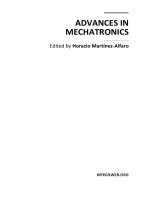Current Trends and Challenges in RFID Part 1 doc
Bạn đang xem bản rút gọn của tài liệu. Xem và tải ngay bản đầy đủ của tài liệu tại đây (758.56 KB, 30 trang )
CURRENTTRENDSAND
CHALLENGESINRFID
EditedbyCornelTurcu
Current Trends and Challenges in RFID
Edited by Cornel Turcu
Published by InTech
Janeza Trdine 9, 51000 Rijeka, Croatia
Copyright © 2011 InTech
All chapters are Open Access articles distributed under the Creative Commons
Non Commercial Share Alike Attribution 3.0 license, which permits to copy,
distribute, transmit, and adapt the work in any medium, so long as the original
work is properly cited. After this work has been published by InTech, authors
have the right to republish it, in whole or part, in any publication of which they
are the author, and to make other personal use of the work. Any republication,
referencing or personal use of the work must explicitly identify the original source.
Statements and opinions expressed in the chapters are these of the individual contributors
and not necessarily those of the editors or publisher. No responsibility is accepted
for the accuracy of information contained in the published articles. The publisher
assumes no responsibility for any damage or injury to persons or property arising out
of the use of any materials, instructions, methods or ideas contained in the book.
Publishing Process Manager Davor Vidic
Technical Editor Teodora Smiljanic
Cover Designer Jan Hyrat
Image Copyright Eric Strand, 2010. Used under license from Shutterstock.com
First published July, 2011
Printed in Croatia
A free online edition of this book is available at www.intechopen.com
Additional hard copies can be obtained from
Current Trends and Challenges in RFID, Edited by Cornel Turcu
p. cm.
ISBN 978-953-307-356-9
free online editions of InTech
Books and Journals can be found at
www.intechopen.com
Contents
Preface IX
Part 1 RF/RFID Backgrounds 1
Chapter 1 Radio Frequency Background 3
Tales Cleber Pimenta, Paulo C. Crepaldi and Luis H. C. Ferreira
Chapter 2 Main RF Structures 17
Tales Cleber Pimenta, Paulo C. Crepaldi, Luis H. C. Ferreira,
Robson L. Moreno and Leonardo B. Zoccal
Chapter 3 RF CMOS Background 37
Tales Cleber Pimenta, Robson L. Moreno and Leonardo B. Zoccal
Chapter 4 Structural Design of a CMOS Voltage
Regulator for an Implanted Device 53
Paulo C. Crepaldi, Luis H. de C. Ferreira,
Tales C. Pimenta, Robson L. Moreno,
Leonardo B. Zoccal
and Edgar C. Rodriguez
Part 2 Antennas/Tags 85
Chapter 5 RFID Technology: Perspectives and Technical
Considerations of Microstrip Antennas for
Multi-band RFID Reader Operation 87
Ahmed Toaha Mobashsher, Mohammad Tariqul Islam
and Norbahiah Misran
Chapter 6 Low-Cost Solution for RFID Tags in Terms
of Design and Manufacture 113
Chi-Fang Huang
Chapter 7 Conductive Adhesives as the Ultralow Cost
RFID Tag Antenna Material 127
Cheng Yang and Mingyu Li
VI Contents
Chapter 8 Key Factors Affecting
the Performance of RFID Tag Antennas 151
Yung-Cheng Hsieh, Hui-Wen Cheng and Yu-Ju Wu
Chapter 9 Troubleshooting RFID Tags Problems
with Metallic Objects Using Metamaterials 171
Mª Elena de Cos and Fernando Las-Heras
Chapter 10 High Performance UHF RFID Tags for
Item-Level Tracing Systems in Critical Supply Chains 187
Luca Catarinucci, Riccardo Colella, Mario De Blasi,
Luigi Patrono and Luciano Tarricone
Part 3 Readers 209
Chapter 11 Design and Implementation of Reader Baseband
Receiver Structure in a Passive RFID Environment 211
Ji-Hoon Bae, Kyung-Tae Kim, WonKyu Choi and Chan-Won Park
Chapter 12 RFID Readers for the HDX Protocol
- A Designer’s Perspective 229
Dan Tudor Vuza and Reinhold Frosch
Part 4 Protocols and Algorithms 255
Chapter 13 F-HB
+
: A Scalable Authentication Protocol
for Low-Cost RFID Systems 257
Xiaolin Cao and Máire P. O’Neill
Chapter 14 RFID Model for Simulating Framed Slotted ALOHA Based
Anti-Collision Protocol for Muti-Tag Identification 279
Zornitza Prodanoff and Seungnam Kang
Chapter 15 Using CDMA as Anti-Collision Method for RFID
- Research & Applications 305
Andreas Loeffler
Chapter 16 An Unconditionally Secure Lightweight RFID
Authentication Protocol with Untraceability 329
Hung-Yu Chien, Jia-Zhen Yen and Tzong-Chen Wu
Chapter 17 Application of Monte Carlo Method for Determining
the Interrogation Zone in Anticollision Radio Frequency
Identification Systems 335
Piotr Jankowski-Mihułowicz and Włodzimierz Kalita
Chapter 18 Iterative Delay Compensation Algorithm to
Mitigate NLOS Influence for Positioning 357
Koji Enda and Ryuji Kohno
Contents VII
Chapter 19 Efficient Range Query Using Multiple Hilbert Curves 375
Ying Jin, Jing Dai and Chang-Tien Lu
Part 5 Case Studies/Applications 391
Chapter 20 The Study on Secure RFID Authentication
and Access Control 393
Yu-Yi Chen
and Meng-Lin Tsai
Chapter 21 Attacks on the HF Physical Layer
of Contactless and RFID Systems 415
Pierre-Henri Thevenon, Olivier Savry,
Smail Tedjini
and Ricardo Malherbi-Martins
Chapter 22 Tag Movement Direction Estimation Methods
in an RFID Gate System 441
Yoshinori Oikawa
Chapter 23 Third Generation Active RFID
from the Locating Applications Perspective 455
Eugen Coca and Valentin Popa
Chapter 24 Optimization of RFID Platforms:
A Cross-Layer Approach 477
Ramiro Sámano-Robles and Atílio Gameiro
Preface
Radio‐frequency identification (RFID) is a technology that uses communication
throughradiowavestotransferdatabetweenareaderandanelectronictagattached
to an entity for the purpose of identification, tracking and surveillance. Unlike other
identification technologies such as barcodes, RFID technology offers several key
benefits such as
no line‐of‐sight necessity, robustness, speed, bidirectional
communication, reliability in tough environments, bulk detection, superior data
capabilities, etc. Because of this, RFID has become particularly successful for a wide
area of applications where traditional identification technologies are inadequate for
recent demands: inventory tracking, supply chain management, automated
manufacturing,healthcare,etc.
AstheRFIDtechnologyisbeingspreadandappliedto
real world system, RFID systems have received considerable attention from
researchers,engineersandindustrypersonnel.Asaresultofyearsofresearch,alotof
literature has been published on the design and use of the RFID systems, covering a
wide range of topics: hardware and software, protocols and algorithms,applications,
etc.
ThisbookpresentssomeofthemostrecentresearchresultsofRFIDusersinterestedin
exchanging ideas on the present development issues of and future trends in RFID
technology. It consists in a collection of 24 chapters distributed in 5 parts: RF/RFID
Backgrounds, Antennas/Tags, Readers, Protocols and Algorithms, and finally, Case
studies/Applications.
The book starts with some background chapters related to Radio Frequency (Chapter
1),mainRFstructures(Chapter2)andRFCMOS(Chapter3).Also,thissectioncontains
a chapter that deals with structural design
of a CMOS voltage regulator for an
implanteddevice(Chapter4).
Thesecondsectionofthebookfocusesonantennasandtags.First,someperspectives
and technical considerations of microstrip antennas for multi‐band RFID reader are
presented (Chapter 5). Also, the high gain dual‐band antennas and limitations
have
been described. Chapter6 includes low‐cost solution forRFID tags interms of design
and manufacture considering that applying the traditional printing technologies to
produce the antennas will lower the cost of the antenna part. Chapter 7 deals with
conductive adhesives such as the ultralow cost RFID tag antenna material and
X Preface
includes results which are based on the screen printing method, which is very
representativeatthestageoflabprototyping.Chapter8isatrueexperimentalresearch
in nature and aims to investigate the process consistency and accuracy of printing
RFID tag antennas via the screening printing method with a conductive
ink, silver‐
based (Ag) ink, on PET, PVC, and Wet Strength paper. Chapter 9 presents a novel
CPW‐fed‐slotantennaonartificialmagneticconductor(AMC)combinationprototype
suitable to be used in 5.8 GHz RFID tags on metallic objects. The last chapter of this
section(Chapter10)proposes
aguidelineforthedesignofanewkindofRFIDtagtobe
usedineachstepofthepharmaceuticalsupplychain.Itdescribesthemainfeaturesof
thepharmaceuticalscenario, mainly focusingonitem‐leveltracingsystemsandRFID
devices’performance.
The third section of the book is dedicated
to RFID readers. In Chapter 11 the authors
presenta demodulationstructuresuitableforareader baseband receiver inapassive
RFID environment. Chapter 12 introduces a new reader obtained by adding HDX
functionality to an existing FDX reader, together with some design issues that
influencereaderperformance.
After the
chapters focusing on readers design, the following chapters present certain
aspects relatedto protocols and algorithms. InChapter 13 the authors propose a new
scalable authentication protocol for low‐cost RFID systems, for which features are
presented,bothfromthetag’sandreader’sperspective.Chapter14focusesonanRFID
model
for simulating framed slotted ALOHA based anti‐collision protocol for multi‐
tag identification. Chapter 15 describes the implementation of direct sequence code
divisionmultipleaccesschannelaccessmethodsforthe UHF‐RFID uplink.Chapter16
illustrates an unconditionally secure lightweight RFID authentication protocol with
untraceability. Chapter 17 deals with the application of Monte Carlo method for
determiningtheinterrogationzoneinanti‐collisionRadioFrequency.InChapter18, in
order to mitigate the influence of the NLOS propagation, the authors propose an
iterative delay compensation algorithm based on NEWTON algorithm which
improves the accuracy of positioning items using the DCF and
shift vector
compensationalgorithm.Finally,inChapter19,anefficientspatialrangequerymethod
is designed for compensating the lost spatial relationship by the linear mapping
mechanisms. The experiments conducted on real data sets demonstrate that the
proposedapproachisefficientandscalable.
The fifth section of the book includes
5 chapters that describe several RFID
applications and studies. Chapter 20 presents some studies on secure RFID
authentication and access control, while Chapter 21 shows an overview of attacks on
the HF physical layer of contactless and RFID systems. Chapter 22 proposes an
effective tag movement direction detection method. Chapter 23
presents a distance
measurementandpositionestimationapplicationinordertoevaluateaWSNsystem.
Finally,in Chapter 24,cross‐layer designispresented as anattractive tool tooptimize
RFID platforms. The proposed framework for design of RFID platforms can be
Preface XI
potentially used for a wide variety of PHY and MAC algorithms under a cross‐layer
philosophy.
By presenting design issues related to each component of an RFID system, this book
reaches its goal, that of beinga collectionof actual research results and challenges in
RFIDdomain.Itcompletesacollection
ofRFIDbookspublishedbyIntech,acollection
that is a valuable tool for engineers, researchers and industry personnel, either those
thatarealreadyfamiliarwithRFIDornewtothisfield.
CornelTurcu
UniversityofSuceava
Romania
Part 1
RF/RFID Backgrounds
1
Radio Frequency Background
Tales Cleber Pimenta, Paulo C. Crepaldi and Luis H. C. Ferreira
Universidade Federal de Itajuba
Brazil
1. Introduction
Design considerations for the traditional low frequency circuits and the RF circuits are quite
different. In low frequency design, the maximum signal transfer occurs when the source
presents low impedance while the load presents high impedance. A typical example is a
buffer, where the input impedance is high and the output impedance is low. As long as that
requirement is fulfilled, the designer is capable of choosing arbitrary levels of impedance
that best suits the circuit requirements or applications.
Therefore this chapter aims to provide background on impedance matching between source
and load, with or without a transmission line. The analysis can be conducted by using Smith
Charts and S-Parameters, which are also presented in this chapter. The analysis in this
chapter is oriented to RFID applications whereas other books provide general analysis.
During RF design, the impedances should be matched for maximum signal transfer.
Additionally, when the circuits are connected using transmission lines, they should match
also the standard values of the transmission lines. At very low frequencies, transmission
lines can be thought as just a wire. Nevertheless, at high frequencies, the signal wavelength
is comparable to or smaller than the length of the transmissions line and power can be seen
as traveling waves. As a matter of fact, even a conductor can be thought as a transmission
line in a high frequency circuit.
Most RF equipments and coaxial cables use the standard impedances of 50 or 75 Ω. The
value of 75 Ω is used, as an example, in cable TV equipment, since this value provides the
minimum losses, as it is desired in transmitting the signal over long distances. In fact, the
value of impedance for minimum loss should be 77 Ω, but it was rounded to 75 Ω by
convenience.
The value of 50 Ω corresponds to a reasonable compromise, the average, between the
minimum loss of a 77 Ω and the maximum power handling capability given of 30 Ω.
2. Transmission line
Fig. 1 shows the lumped component model of a real (lossy) transmission line. The segment
indicated corresponds to an infinitesimal segment of the transmission line. The characteristic
impedance Z
0
of this line can be found to be [1]:
0
RjL
Z
Z
YGjC
(1)
Current Trends and Challenges in RFID
4
RL
GC
RL
GC
RL
GC
Fig. 1. Lumped component model of a transmission line.
As can be observed, the characteristic impedance Z
0
is dependent on the frequency.
Nevertheless, if the resistive terms R and G are negligible, the expression of the
characteristic impedance Z
0
can be simplified to:
0
L
Z
C
(2)
If the value of RC is equal to GL, expression (1) yields the same value of expression (2). In
other words, choosing the L/R time constant of the series impedance equals to the C/G time
constant, a lossy line will behave as a lossless line, so that its characteristic impedance will
be independent of the frequency[1].
2.1 Reflection coefficient
If a transmission line is terminated by an impedance Z
0,
then a signal traveling down the
line with a ratio of voltage to current equal to Z
0
will maintain its ratio upon encountering
the load and there will be no reflections. On the other hand, when the load is different of Z
0
,
then it imposes its own particular ratio of voltage to current, and the only way to reconcile
the conflict is by having some of the signal reflected back towards the source. In order to
distinguish the incident and the reflected signals, the subscripts i and r, respectively, will be
used.
The incident signal is given by:
0
i
i
E
Z
I
(3)
At the load end, the mismatch in impedances gives rise to a reflected signal. Since the
system is still linear, the total voltage at any point in the system is the sum of incident and
reflected voltages. The net current is superposition of incident and reflected currents.
However, since the currents are traveling in opposite directions, the net current is the
difference between them. Therefore, the load impedance is given by:
ir
L
ir
EE
Z
II
(4)
Radio Frequency Background
5
Expression (4) can be rewritten to express Z
L
as function of Z
0
as:
0
1/ 1/
1/ 1/
ir i ri ri
L
ir i r i r i
EE E EE EE
ZZ
II I EE EE
(5)
The ratio of reflected to incident quantities at the load end of the line is called Reflection
Coefficient Γ
L
. Therefore, expression (5) can be rewritten as:
0
1
1
ir
L
L
ir L
EE
ZZ
II
(6)
Solving for Γ
L
yields:
0
0
L
L
L
ZZ
ZZ
(7)
As can be observed from expression (7), if the impedances of the load and the line are equal,
there will be no reflection. If the line is terminated in either a short or an open circuit, the
reflection will be maximum, with a magnitude of 1 [1].
Therefore, if a transmission line is terminated by its characteristic impedance there will be
no reflection since all the transmitted power is absorbed by the load and the energy flows in
just one direction.
When the line is terminated by a short circuit a reflected wave is sent back to the source
since the short can not sustain any voltage, and therefore dissipates zero power. The
incident and the reflected voltage waves are of the same magnitude. They are 180
o
out of
phase at the load and they travel in opposite directions.
If the line is terminated by an open circuit a reflected wave is sent back to the source since
the open can not sustain any current, and therefore dissipates zero power. The incident and
the reflected current waves are of the same magnitude and travel in opposite directions. The
current waves are 180
o
out of phase at the load, but the incident and reflected voltage waves
are in phase [1].
If the line is terminated by an impedance different of the short, open and characteristic
impedance, part of the signal will be absorbed by the load and part will be reflected back.
The amount of reflected signal is given by expression (7).
3. Smith chart
The reflection coefficient Γ
L
of expression (7) was obtained from expression (6). By the same
way, solving for Z
L
in expression (7) yields Γ
L
, thus forming a mapping of one complex
number into another. The relationship between these two complex numbers forms a bilinear
transformation, which means that knowing one is equivalent to knowing the other.
Since Z
L
can have any value and |Γ
L
| cannot exceed unity for passive loads, it is therefore
much more convenient plotting Γ
L
than plotting Z
L
.
The reflection coefficient can become even more convenient by normalizing it to Z
0
, as:
0
0
1
1
1
1
L
L
Z
Z
Z
Z
Z
Z
(8)
Current Trends and Challenges in RFID
6
On the same way, normalizing (6) results in:
1
1
Z
(9)
Considering the normalized real and imaginary parts of both Γ and Z then:
1
1
11
ri
ri
j
ZRjX
j
(10)
After some algebraic manipulation (using conjugate), the real and imaginary parts are of Z
are:
22
22
1
12
ri
rri
R
(11)
22
2
12
i
rri
X
(12)
Expression (11) can be manipulated as:
2222
2 222
2 222
2
2 222
2
22
2
22
22
21
21
(1 )
2(1)
(1 )
1
2
(1 ) (1 )
1
(1 ) 2 (1 )
(1 ) (1 )
1
2
(1)
(1 ) (1 )
rri ri
rriri
rriri
rriri
rri
rr i
r
RR R R
RRR R
R
RRR R
R
R
RRR
RR
R
RR R
RR
RR
R
RR
22
2
1
11
i
R
RR
(13)
Similarly, expression (12) into:
2
2
2
11
1
ri
X
X
(14)
When the two parametric equations (13) and (14) are drawn on a complex coordinate, they
build the Smithchart. Equation (13) forms resistance circles, and equation (14) generates
reactance circles, as shown in Fig. 2 and Fig. 3, respectively. The resulting Smithchart is
illustrated in Fig. 4.
As can be verified from expression (13), the imaginary axis in the Z-plane (resistance equals
0) is mapped as a unity circles into Γ-plane. The other lines of constant resistance in the Z-
plane are also mapped as circles, but of different diameter in the Γ-plane. Nevertheless, they
Radio Frequency Background
7
are all tangent at the point Γ=1, as shown in Fig. 2. The larger the value of the resistance, the
smaller becomes the circle [1, 2].
R
X
r
i
Z Plane
Plane
1
Fig. 2. Mapping of Z-plane into Γ-plane for constant resistances.
As can be verified from expression (14), lines of constant reactance are perpendicular to lines
of constant resistance in the Z-plane. This same orthogonality is preserved in the Γ-plane by
having arcs perpendicular to the constant resistance lines, as indicated in Fig. 3.
R
X
Z Plane
Plane
1
-1
i
r
Fig. 3. Mapping of Z-plane into Γ-plane for constant reactances.
Current Trends and Challenges in RFID
8
The Smith, as shown in Fig. 4, is just the plotting of both constant resistance and constant
reactance, but without the presence of the Γ axes. The center of the Smith chart corresponds
to zero reflection (Z
L
equals Z
0
)[1].
i
r
01
x=1
x=1/2
x=-1
x=-1/2
x=0
0
r=0
r=1
r=∞
Fig. 4. Smith chart.
The upper half of the Smith chart corresponds to the upper half part of the Z-plane, and
therefore presents inductive loads. On the same way, the bottom half of the Smith chart
corresponds to the bottom half part of the Z-plane, thus representing capacitive loads.
Obviously, the Re axis of the Smith chart represents purely resistive loads.
Although the Smith chart presents many interesting and useful properties, they will no be
presented here due to the focus of this material.
2.1 Admittance chart
The Smithchart is built by considering impedance (resistance and reactance). Once the
Smithchart is developed, a similar approach can be used for admittance analysis. The
concept that admittance is the inverse of impedance is very important for parallel circuit
synthesis. Adding new elements in series can be resolved easily by adding the impedance
values. However, summing elements in parallel can be cumbersome in terms of impedance.
Thus, admittance is often considered for parallel elements.
By definition, admittance is expressed as:
jBG
Z
Y
1
(15)
where G is conductance and B is susceptance of the element. The reflection coefficient Γ can
be expressed in terms of normalized admittance as:
Radio Frequency Background
9
jbg
jbg
y
y
YY
YY
YY
YY
ZZ
ZZ
j
L
L
L
L
L
L
ir
1
1
1
1
11
11
0
0
0
0
0
0
(16)
The admittance reflection coefficient Γ(y) is given by definition as:
0
()
0
L
Y
L
YY
YY
(17)
As can be observed, the value of the admittance reflection coefficient Γ(y) is equal to –Γ, the
reflection coefficient in terms of impedance. Therefore, once Γ is known, Γ(y) can be located
a point at the same distance from the origin. Rotating the admittance point by 180° around
the origin achieves the same result.
The admittance Smithchart can be obtained using the same procedure used to construct the
impedance Smithchart. The normalized real and imaginary parts of Γ and Y can be given as:
22
22
12
12
ri i
rii
j
YGjB
(18)
After some algebraic manipulation (using conjugate), the real and imaginary parts are of Y
are:
22
22
1
12
ri
rri
G
(19)
22
2
12
i
rri
B
(20)
Using the same procedure presented for expressions (13) and (14), then the parametric
equations of the admittance Smithchart are:
22
2
1
11
ri
G
GG
(21)
2
2
2
11
1
ri
B
B
(22)
When the two parametric equations (21) and (22) are drawn on a complex coordinate, they
build the Admittance Smithchart. Equation (21) forms resistance circles, and equation (22)
generates reactance circles, as shown in Fig. 5.
3. S Parameters
At low frequencies, linear systems can be analyzed by means of voltages and currents
applied to its ports. The two port circuit shown in Fig. 5 could be analyzed from its
Current Trends and Challenges in RFID
10
impedance (Z-parameters), admittance (Y-parameters), or a mixture of them, which could
be hybrid (H-parameters) and inverse-hybrid (G-parameters).
i
r
Fig. 5. Admittance Smithchart.
Two-Port
V
1
+
-
V
2
+
-
I
1
I
2
Fig. 6. Two port circuit representation.
As an example, the circuit of Fig. 5 could be analyzed using H parameters whose equations
are:
1111122
2211222
VhIhV
IhIhV
(16)
As can be observed from the equations, the value of h
11
(port 1 impedance) can be obtained
directly from the relationship of V
1
and I
1
when V
2
is set to zero. A voltage source is set to
zero by shortening its terminals. The value of h
21
(current gain from port 1 to port 2) is
obtained from the relationship of I
1
and I
2
also when V
2
is set to zero.
By the same way, h
12
(voltage gain from port 2 to port 1) can be obtained from the
relationship of V
1
and V
2
when I
1
is set to zero. A current source is set to zero by opening its
Radio Frequency Background
11
terminals. Finally, h
21
(port 2 conductance) is obtained from the relationship of V
2
and I
2
when I
1
is set to zero.
Shorting or opening terminals is feasible at low frequencies but virtually impossible at high
frequencies, particularly over a broad range of frequencies. Additionally, RF circuits are
very sensitive to impedances, and they may oscillate or just quit working when terminated
with open or short circuits. Therefore, Z-parameters, Y-parameters, H-parameters and G-
parameters are not suitable to high frequency operations.
For high frequency operations, the scattering parameters (or just S-parameters) are
employed. The input and output variables in S-parameters are based on incident and
reflected voltage waves instead of voltages and currents.
The S-parameters takes advantage of the fact that there is no reflection in a line terminated
in its characteristic impedance. Therefore, it is necessary a circuit representation for S-
parameters, where source and the load terminations are Z
0
, as shown in Fig. 6.
The S-parameters equations are:
1111122
2211222
bsasa
bsasa
(16)
where
11 0
22 0
11 0
12 0
/
/
/
/
i
i
r
r
aE Z
aE Z
bE Z
bE Z
(17)
The normalization by
0
Z is very convenient since the square of a and b corresponds to the
power of the incident and reflected waves.
S
11
and S
21
can be obtained by measuring the incident, the reflected and the transmitted
signals at the input when the output is terminated in
Z
0
. Once the output is terminated by Z
0
there is no reflection. The values of
S
11
and S
21
are:
1
1
11 1
11
2
2
21
11
r
i
r
i
E
b
S
aE
E
b
S
aE
(18)
Similarly,
S
12
and S
22
can be obtained by measuring the incident, the reflected and the
transmitted signals at the output when the input is terminated in
Z
0
. Since the input is
terminated by
Z
0
there is no reflection. The values of S
12
and S
22
are:
1
1
12
22
2
2
22 2
22
r
r
r
i
E
b
S
aE
E
b
S
aE
(19)
Current Trends and Challenges in RFID
12
S
11
corresponds to the input reflection coefficient, S
21
is the input to output (direct) gain, S
12
is the reverse transmission gain and
S
22
corresponds to the output reflection coefficient.
The magnitudes of
S
11
and S
22
are always less than 1, where a value of zero represents a
perfect matching (no reflections), and the closer to 1, the higher the reflection.
The magnitudes of
S
21
(transfer characteristic) and S
12
(reverse) are smaller than 1 for
passive circuits but can exceed 1 for active circuits (amplification). A positive value means
the input and output signal are in phase and a negative indicates a phase shift.
Two-Port
E
i1
Z
0
Z
0
E
i2
E
r1
E
r2
Fig. 7. Two port circuit representation for S-parameters.
3.1 Measurements of S-Parameters
The circuit topology used to measure S-Parameters is given in Fig. 7.
Two-Port
Z0
Z0
V2V1VS
Fig. 8. Circuit topology used to measure S-Parameters.
The input reflection coefficient
S
11
from expression (18) can be modified as:
0
11 1
00
2. 1
L
L
LL
ZZ
Z
S
ZZ ZZ
(20)
This expression, using the concepts of voltage division, corresponds to:
1
11 1
0
2. 1 2. 1
L
LS
ZV
S
ZZ V
(21)
Here,
Z
L
corresponds to the input impedance of the two-port circuit. The value of the input
to output gain,
S
21
is given as:
2
21
2.
S
V
S
V
(22)
The value of
S
22
and S
12
can be obtained in a similar way by just exchanging input and
output terminals.
Radio Frequency Background
13
3.1 S Parameters in the Smith chart
The center point of the Smith chart corresponds to the point of zero reflection, where Z
L
equals
Z
0
. Plots of S
11
and S
22
on the real axis represent ohmic resistors, above the axis
indicate inductive load while below the axis indicate capacitive loads.
Plots of
S
12
and S
21
inside the Smith chart indicate that damping signal between ports,
whereas plots outside the chart indicate amplification [1].
As the frequency increases, the S-Parameters plots in the Smith chart move clockwise.
Given the value of
S
11
, the circuit impedance can be found from (6), as:
11
0
11
1
1
L
S
ZZ
S
(23)
3.2 Application example
The S
11
and S
21
parameters can be obtained as given by expressions (21) and (22), indicated
in Fig. 7, and the values are calculated as for
S
11
and S
21
, respectively. As an application
example, consider the cascode amplifier shown in Fig. 8 [2].
Fig. 9. Cascode amplifier.
Fig. 10 shows its
S
11
parameter, in the Smith chart. The frequency is ranging from 4GHz to
6GHz. As the frequency increases, the plot moves clockwise. At approximately 5GHZ, the
circuit presents a pure resistive impedance of approximately 50Ω (it crosses the horizontal
axis). The circuit presents a capacitive behavior for frequencies bellow 5HGz and an
inductive behavior for higher frequencies [1].
The same parameters could be plotted in a standard dB format, as shown in Fig. 11. The
graph of Fig. 10 provides more information and insight than the graph of Fig. 11. The last
one provides only the magnitude, whereas the first one provides both the imaginary and
real part, so that it is possible to infer a capacitive and/or inductive behavior of the circuit,
among other information.









